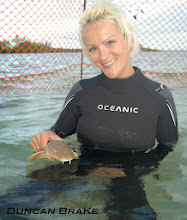I have not spent much time in the water in South Florida since 2007. It was then that I was working as an instructor and loved exploring the endless artificial reefs that this part of the world is known for. My favorite was Aqua Zoo, a site where I made friends with Baby, an 8 foot green moray eel with a dislocated jaw and even did a magazine photo shoot with her. Bull sharks, nurse sharks, massive schools of Atlantic spade fish, ancient barracudas guarding their thrones and midnight parrot fish sleeping upside down, nestled into the dark nooks and crannies of a sunken ship-all some of my favorite things and all things that I have neglected for several years.
When the chance came to dive and film in the Keys I jumped at it. The shoot was for a high school biology video series called “ That’s Amazing,” with Dr. Mike Heithaus as host. It is estimated that 30 million students will view the series within the next 6 years. I absolutely love working on outreach and education projects, so this was an exciting opportunity.It also meant working with Pat Greene of Symbio Studies again.Breaking south from the city chaos, the Florida Keys are the closest to island paradise that one can find in the continental United States. Thatched roof bars, sunset ales and marine protected areas teaming with fish-always a good time.

I was sitting in the Atlanta airport with 25 hours of travel behind me and another 4 to go when a glorious epiphany struck. We were set to arrive late on the evening of the 3rd and I thought that the shoot was on the 4th. I figured one day would not kill us and that we could sleep the day after. We had made the plan to get the rental car at the airport, swing by the apartment and make the drive to Key Largo that night. This would have had us arriving at our destinations sometime around 2 am. It’s always good to go diving in a jet lagged, sleep deprived state reminiscent to a zombie, right? Ah well time to sleep when we are dead. Aforementioned epiphany hit me like a bolt of lightening and was almost like Christmas morning. I was off a day because we had crossed the international dateline. We were arriving on the 2nd, the same day we left and would not have to get the car until the following afternoon. AMAZING.
I crumbled into my bed and disappeared into 12 hours of sleep. I never do that, but wow, it was incredible. Feeling remotely human again we loaded the camera and dive equipment into our Mazda 6 (sweet little upgrade on the rental car because they did not have any economy cars) and headed south. We met the crew and enjoyed a meal under a thatched roof in the cool evening breeze and made our dive plan.
Our dive started at 7:00 AM the next morning with the goal of exploring 2-3 sites and collect fish and coral samples for Dr. Rebecca Vega and Dr. Deron Burkepile of Florida International University. Our first site was about 60 ft and involved catching reef fish. As soon as I put my face in the water I could see the bottom. Yes, good visibility for filming. In order to catch fish a net is placed and smaller hand nets are used to corral fish towards the larger one. Dr Mike Heithaus zipped around catching the first fish he went after, making it look like a piece of cake. While pushing around the bus, also know as the Gates underwater housing with camera inside, I was wishing I had worn my freediving fins for a bit more propulsion. This was nothing short of a vigorous activity to shoot.

The next dive was a shallow reef covered with life. The goal was to collect mucus from corals to analyze at the lab and compare to the bacteria found in the mouths of the reef fish. As soon as I slipped into the sea a 4-foot nurse shark cruised past. Schools of French grunts decorated massive sea fans and squirrel fish peaked out from caves carved into the reef. Healthy brain corals and were home to Christmas tree worms and flamingo tongues found perfect positions on purple sea fans. These articulately decorated critters were some of my first subjects in underwater imaging. Searching for these tiny treasures was already one of my favorite parts of diving. Mega fauna are easy to spot, but sometimes the mini rulers of the reef can be more exciting.

With the samples collected the crew would need to head back to the lab. That was a wrap for our dive day. I hated to leave to perfect conditions of prolific life on the reef. In a day where there is little good news about our oceans and the battles they face, it is nice to see a healthy space that will continue to be protected.


No comments:
Post a Comment